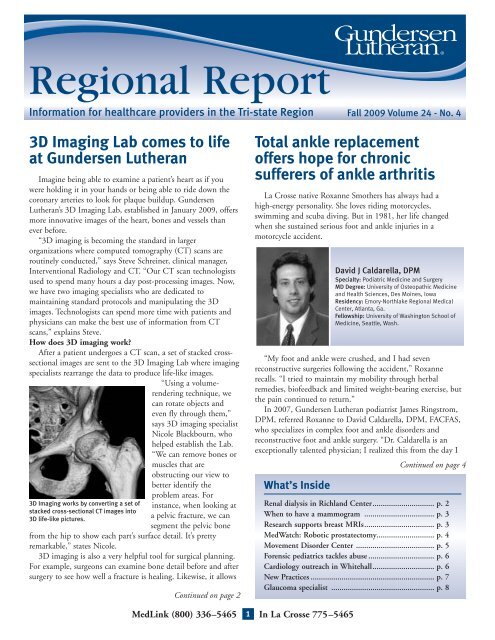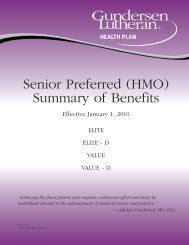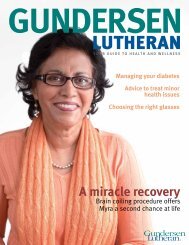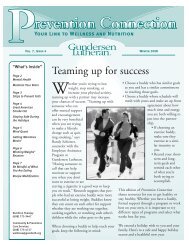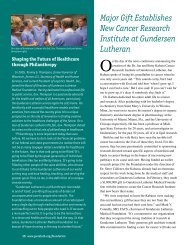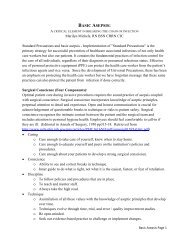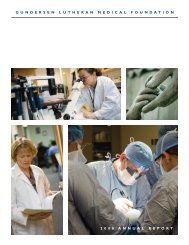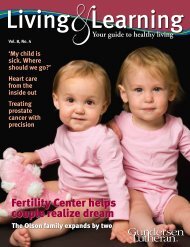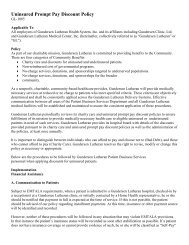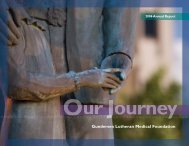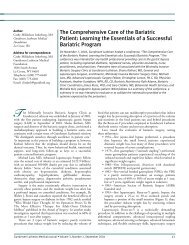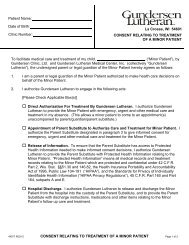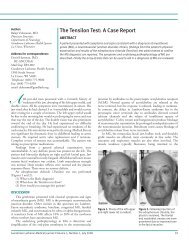Regional Report - Gundersen Health System
Regional Report - Gundersen Health System
Regional Report - Gundersen Health System
Create successful ePaper yourself
Turn your PDF publications into a flip-book with our unique Google optimized e-Paper software.
<strong>Regional</strong> <strong>Report</strong><br />
Information for healthcare providers in the Tri-state Region<br />
Fall 2009 Volume 24 - No. 4<br />
3D Imaging Lab comes to life<br />
at <strong>Gundersen</strong> Lutheran<br />
Imagine being able to examine a patient’s heart as if you<br />
were holding it in your hands or being able to ride down the<br />
coronary arteries to look for plaque buildup. <strong>Gundersen</strong><br />
Lutheran’s 3D Imaging Lab, established in January 2009, offers<br />
more innovative images of the heart, bones and vessels than<br />
ever before.<br />
“3D imaging is becoming the standard in larger<br />
organizations where computed tomography (CT) scans are<br />
routinely conducted,” says Steve Schreiner, clinical manager,<br />
Interventional Radiology and CT. “Our CT scan technologists<br />
used to spend many hours a day post-processing images. Now,<br />
we have two imaging specialists who are dedicated to<br />
maintaining standard protocols and manipulating the 3D<br />
images. Technologists can spend more time with patients and<br />
physicians can make the best use of information from CT<br />
scans,” explains Steve.<br />
How does 3D imaging work?<br />
After a patient undergoes a CT scan, a set of stacked crosssectional<br />
images are sent to the 3D Imaging Lab where imaging<br />
specialists rearrange the data to produce life-like images.<br />
“Using a volumerendering<br />
technique, we<br />
can rotate objects and<br />
even fly through them,”<br />
says 3D imaging specialist<br />
Nicole Blackbourn, who<br />
helped establish the Lab.<br />
“We can remove bones or<br />
muscles that are<br />
obstructing our view to<br />
better identify the<br />
3D Imaging works by converting a set of<br />
stacked cross-sectional CT images into<br />
3D life-like pictures.<br />
problem areas. For<br />
instance, when looking at<br />
a pelvic fracture, we can<br />
segment the pelvic bone<br />
from the hip to show each part’s surface detail. It’s pretty<br />
remarkable,” states Nicole.<br />
3D imaging is also a very helpful tool for surgical planning.<br />
For example, surgeons can examine bone detail before and after<br />
surgery to see how well a fracture is healing. Likewise, it allows<br />
Continued on page 2<br />
Total ankle replacement<br />
offers hope for chronic<br />
sufferers of ankle arthritis<br />
La Crosse native Roxanne Smothers has always had a<br />
high-energy personality. She loves riding motorcycles,<br />
swimming and scuba diving. But in 1981, her life changed<br />
when she sustained serious foot and ankle injuries in a<br />
motorcycle accident.<br />
“My foot and ankle were crushed, and I had seven<br />
reconstructive surgeries following the accident,” Roxanne<br />
recalls. “I tried to maintain my mobility through herbal<br />
remedies, biofeedback and limited weight-bearing exercise, but<br />
the pain continued to return.”<br />
In 2007, <strong>Gundersen</strong> Lutheran podiatrist James Ringstrom,<br />
DPM, referred Roxanne to David Caldarella, DPM, FACFAS,<br />
who specializes in complex foot and ankle disorders and<br />
reconstructive foot and ankle surgery. “Dr. Caldarella is an<br />
exceptionally talented physician; I realized this from the day I<br />
What’s Inside<br />
David J Caldarella, DPM<br />
Specialty: Podiatric Medicine and Surgery<br />
MD Degree: University of Osteopathic Medicine<br />
and <strong>Health</strong> Sciences, Des Moines, Iowa<br />
Residency: Emory-Northlake <strong>Regional</strong> Medical<br />
Center, Atlanta, Ga.<br />
Fellowship: University of Washington School of<br />
Medicine, Seattle, Wash.<br />
Continued on page 4<br />
Renal dialysis in Richland Center.............................. p. 2<br />
When to have a mammogram .................................. p. 3<br />
Research supports breast MRIs.................................. p. 3<br />
MedWatch: Robotic prostatectomy............................ p. 4<br />
Movement Disorder Center ...................................... p. 5<br />
Forensic pediatrics tackles abuse ................................ p. 6<br />
Cardiology outreach in Whitehall.............................. p. 6<br />
New Practices ............................................................ p. 7<br />
Glaucoma specialist .................................................. p. 8<br />
MedLink (800) 336–5465 1 In La Crosse 775–5465
3D Imaging Lab – continued from p. 1<br />
surgeons to point out to patients what will occur during surgery.<br />
“Patients appreciate being able to recognize the anatomy and<br />
understand what their doctor is explaining. With cross-sectional<br />
pictures from a CT scan, this is challenging,” says Becky Freier, CT<br />
scan technologist.<br />
So far, the most common uses of 3D imaging are bone anatomy,<br />
vessel analysis, fractures and trauma cases. As Nicole points out, “It’s<br />
important to know exactly what structures the ordering provider is<br />
looking at so we can create images that are the most efficient for the<br />
radiologist.”<br />
For questions or to learn if your department could benefit from<br />
3D imaging, contact Nicole Blackbourn via MedLink. RR<br />
With advanced<br />
computer technology,<br />
imaging specialist can<br />
now remove bones<br />
(such as the femur) to<br />
get a better look at the<br />
fractured hip socket.<br />
<strong>Gundersen</strong> Lutheran renal dialysis unit comes to Richland Center<br />
<strong>Gundersen</strong> Lutheran provides outpatient renal dialysis in a<br />
number of regional locations—the newest is in the Center<br />
Creek Professional Building in Richland Center, Wis., in<br />
partnership with the Richland Hospital and Richland<br />
Medical Center.<br />
A registered nurse serves as a care manager for each dialysis<br />
patient and the care team also includes licensed practical nurses,<br />
technicians, social worker and registered dietitian. An on-call<br />
nephrologist is always available.<br />
Because of their complex medical problems, it is important<br />
for dialysis patients to see a nephrologist every month. So<br />
<strong>Gundersen</strong> Lutheran nephrologist Kumari Usha, MD, sees<br />
dialysis patients in Richland Center.<br />
Dr. Usha also provides outreach services at the Richland<br />
Medical Center, seeing patients with chronic kidney disease or<br />
conditions such as hypertension and diabetes which can lead to<br />
renal problems.<br />
“Our goal is to catch potential problems early so patients can<br />
avoid dialysis,” Dr. Usha explains. “Early referral to a<br />
nephrologist is important in managing a patient’s chronic<br />
kidney disease. Early intervention is also helpful in managing<br />
anemia and bone disease associated with kidney disease.<br />
Outpatient services also include evaluation of patients with<br />
acid-base abnormalities, electrolyte disturbances, difficult-tocontrol<br />
blood pressure, urinary abnormalities such as blood<br />
and/or protein in the urine and metabolic work up for patients<br />
with recurrent kidney stones.”<br />
“We work with the patient’s primary care provider to<br />
establish an individualized disease management program,”<br />
explains <strong>Gundersen</strong> Lutheran nephrologist Fadi Ghandour,<br />
MD, Nephrology section chair, who also provides outreach and<br />
telemedicine services.<br />
Kumari Usha, MD<br />
Specialty: Nephrology<br />
MD Degree: Government Medical College,<br />
Netaji Subhash Chandra Bose, Jabalpur, India<br />
Residency: University of Texas Medical School,<br />
Houston<br />
Fellowship: University of Missouri Hospital,<br />
Columbia<br />
“We provide patient education about hypertension and<br />
managing other diseases related to kidney failure and kidney<br />
disease,” Dr. Ghandour continues. “Education also helps<br />
patients make informed decisions about different options for<br />
dialysis as well as kidney transplantation if they progress to<br />
end-stage kidney disease.” Currently, <strong>Gundersen</strong> Lutheran<br />
Nephrology offers in-center hemodialysis, home peritoneal<br />
dialysis and home hemodialysis as therapy options for patients<br />
with end-stage kidney disease.<br />
For a consultation or more information about outreach<br />
programs, contact Nephrology via MedLink. RR<br />
<strong>Gundersen</strong> Lutheran Nephrology Outreach<br />
Black River Falls, Wis.: <strong>Gundersen</strong> Lutheran Outpatient Dialysis Center in<br />
Black River Memorial Hospital<br />
Prairie du Chien, Wis.: <strong>Gundersen</strong> Lutheran – Prairie du Chien Clinic and<br />
Dialysis Unit at Prairie du Chien Hospital<br />
Richland Center, Wis.: <strong>Gundersen</strong> Lutheran Outpatient Dialysis Center in<br />
the Center Creek Professional Building and Richland Medical Center<br />
Sparta, Wis.: <strong>Gundersen</strong> Lutheran – Sparta Clinic<br />
Tomah, Wis.: <strong>Gundersen</strong> Lutheran – Tomah Clinic<br />
Viroqua, Wis.: Dialysis Unit at Vernon Memorial Hospital<br />
West Union, Iowa: <strong>Gundersen</strong> Lutheran – West Union Clinic and West<br />
Union Dialysis<br />
MedLink (800) 336–5465 2 In La Crosse 775–5465
<strong>Gundersen</strong> Lutheran disagrees with new<br />
mammography recommendation<br />
Women should continue to have annual mammograms<br />
starting at age 40 according to the clinical breast radiologists at<br />
<strong>Gundersen</strong> Lutheran’s Norma J. Vinger Center for Breast Care.<br />
An announcement by the U.S. Preventive Task Force has<br />
caused a stir, suggesting women don’t need screening<br />
mammograms until age 50, and then every other year, rather<br />
than annually.<br />
“Early detection is the key to saving lives, and annual<br />
mammograms give women the best chance for early detection,”<br />
said Jeannette Gasal-Spilde, MD, a <strong>Gundersen</strong> Lutheran<br />
clinical breast radiologist.<br />
“Screening women age 40-49 is reducing their risk of death<br />
from breast cancer by 15 percent, but because women in their<br />
40s are at lower risk of breast cancer than women 50 and<br />
above, the U.S. Preventative Task Force says the actual number<br />
of lives saved isn’t enough for widespread screening. We<br />
disagree,” said Richard Ellis, MD clinical breast radiologist and<br />
co-director of the breast center at <strong>Gundersen</strong> Lutheran.<br />
“If this is about saving money, <strong>Gundersen</strong> Lutheran has a<br />
better solution,” he adds. “If our team approach to caring for<br />
breast cancer patients was implemented on a national scale it<br />
could save $4.15 billion in healthcare costs.” The model is<br />
centralized and coordinated meaning breast tumors are detected<br />
when they are 24 percent smaller, and the discovery-totreatment<br />
timeline is 2.5 times faster, resulting in 35 percent<br />
lower treatment costs.<br />
<strong>Gundersen</strong> Lutheran is one of only two organizations in the<br />
country with every available accreditation for the full scope of<br />
Research conducted at <strong>Gundersen</strong> Lutheran further explored<br />
the use of a simple blood test that may help reduce the number<br />
of repeat scans and non-diagnostic exams some women<br />
undergo. The research, which was published in the December<br />
issue of the American Journal of Roentgenology, focused on<br />
women who do not have normal menstrual cycles who needed<br />
to have a breast MRI. Breast MRIs are sometimes used to help<br />
diagnose and detect breast cancer and other breast<br />
abnormalities.<br />
“Normally, we try to schedule a woman’s breast MRI<br />
between days three and 14 of her menstrual cycle. This is the<br />
time we can get the clearest images, making it easier to detect<br />
breast cancer,” explains Richard Ellis, MD, the lead author of<br />
the study and a clinical breast radiologist in the Norma J.<br />
Vinger Center for Breast Care at <strong>Gundersen</strong> Lutheran.<br />
However, many premenopausal women do not have normal<br />
menstrual cycles. “Doctors often perform a breast MRI on<br />
these women without considering the timing of the patients’<br />
hormonal cycle,” he says. “This can result in images that don’t<br />
MedLink (800) 336–5465 3 In La Crosse 775–5465<br />
Richard L Ellis, MD<br />
Specialty: Breast Cancer<br />
MD Degree: Southern Illinois University<br />
Medical School, Springfield<br />
Residency: University of Wisconsin Hospitals and<br />
Clinics, Madison<br />
Fellowship: Howard Hughes/NIH, Bethesda, Maryland<br />
and University of Alabama, Birmingham<br />
Jeannette M Gasal Spilde, MD<br />
Specialty: Breast Cancer<br />
MD Degree: University of Texas <strong>Health</strong> Science Center,<br />
San Antonio<br />
Residency: University of Wisconsin in Madison<br />
Fellowship: Lynn Sage Breast Center, Northwestern<br />
Memorial Hospital, Chicago<br />
breast care, diagnosis and treatment from the American College<br />
of Radiology. The La Crosse-based breast center has two<br />
fellowship-trained clinical breast radiologists—Drs. Ellis and<br />
Gasal-Spilde. Dr. Ellis is a Fellow in the Society of Breast<br />
Imaging, one of only 100 in the nation. <strong>Gundersen</strong> Lutheran<br />
was also the first in the nation to achieve the highest level of<br />
distinction from the National Quality Measures for Breast<br />
CentersTM Program.<br />
A white paper highlighting <strong>Gundersen</strong> Lutheran’s Norma J.<br />
Vinger Center for Breast Care and their innovative approach to<br />
providing better care for breast cancer patients while reducing<br />
costs is available online at gundluth.org. RR<br />
Research may help some women avoid repeat breast MRIs<br />
allow for a diagnosis, which means a need for repeat scans.”<br />
Using what is known about the hormones released during a<br />
woman’s cycle and their effects upon breast tissue, Dr. Ellis<br />
reasoned that a simple blood test could be use to determine the<br />
optimal time for the breast MRI. He used the blood test to<br />
time the exam in 11 women with irregular menstrual cycles.<br />
None of the women required a repeat breast MRI.<br />
“This is good news for the ever increasing number of women<br />
who need a breast MRI to help in a breast cancer diagnosis or<br />
who need the scan because they are at a high genetic risk for<br />
breast cancer,” Dr. Ellis comments.<br />
Dr. Ellis’ research was supported by the Norman L. Gillette,<br />
Jr. Breast Cancer Research Fellowship of <strong>Gundersen</strong> Lutheran<br />
Medical Foundation. <strong>Gundersen</strong> Lutheran’s work in breast<br />
cancer research, treatment and outcomes has positioned the<br />
organization as a national leader in breast cancer care. For more<br />
information on research and breast cancer care at <strong>Gundersen</strong><br />
Lutheran, go to gundluth.org. RR
MedWatch<br />
<strong>Gundersen</strong> Lutheran Medical<br />
Foundation is dedicated to advancing<br />
quality healthcare by focusing on research, medical<br />
education and community health outreach. MedWatch highlights the<br />
work of the Foundation, as reported by A. Erik <strong>Gundersen</strong>, MD, retired cardiac surgeon<br />
and vice chairman of <strong>Gundersen</strong> Lutheran Medical Foundation Board.<br />
Robotics offer another option for prostate cancer surgery<br />
Beginning in late 2008, the <strong>Gundersen</strong> Lutheran Urology<br />
department introduced a significant technical advance for the<br />
treatment of prostate cancer, robotic prostatectomy. Since that<br />
time, nearly all prostate cancer surgery has been done in this<br />
manner. By November 2009, more than 120 cases have been<br />
performed.<br />
Robotic prostatectomy is one of several choices available at<br />
<strong>Gundersen</strong> Lutheran for patients with prostate cancer. After a<br />
diagnosis of prostate cancer, a urologist will discuss all of the<br />
options with the patient along with the risks and benefits of<br />
each.<br />
For patients with prostate cancer and no evidence that it has<br />
spread beyond the prostate gland, the two most common<br />
choices are robotic prostatectomy and radioactive seed<br />
implantation. Both procedures have advantage and<br />
disadvantages.<br />
With robotic prostatectomy the entire prostate gland is<br />
removed through several small incisions. Pain and blood loss<br />
are generally minimal and there is usually only an overnight<br />
stay. Patients are able to start resuming normal activities after<br />
two weeks.<br />
Most patients regain full continence within several months.<br />
Those patients with normal erectile function before surgery<br />
have a 60-70 percent chance of regaining erectile function. As<br />
with any treatment, there is a chance the cancer may recur after<br />
surgery, but if it does, most patients could have radiation as a<br />
secondary treatment option.<br />
The robotic prostatectomy surgical program began at<br />
<strong>Gundersen</strong> Lutheran less than two years ago; consequently<br />
long-term follow up is not yet available. However, large studies<br />
have shown it to be as effective for controlling cancer as<br />
traditional open prostatectomy with faster patient recovery.<br />
So, who makes the choice for the patient’s treatment? At<br />
<strong>Gundersen</strong> Lutheran the urologist and the radiation oncologist<br />
work with the patient to choose a treatment option that is best<br />
for him. RR<br />
Total ankle replacement – continued from p. 1<br />
met him,” says Roxanne. “He suggested a two-staged approach,<br />
including a Total Ankle Replacement ® —a procedure which<br />
preserves ankle motion.”<br />
According to Dr. Caldarella, the ideal candidates for the<br />
procedure are individuals with advanced arthritis of the ankle,<br />
those who have not responded to previous treatment options,<br />
and patients who are not excessively overweight, neuropathic or<br />
have metabolic bone disorders. Roxanne fit the description<br />
perfectly, but first she needed a repositional triple arthrodesis to<br />
straightened her foot alignment.<br />
Dr. Caldarella completed the triple arthrodesis surgery at<br />
<strong>Gundersen</strong> Lutheran and then worked alongside board-certified<br />
orthopedic surgeon Gregory Berlet, MD, at the Orthopedic<br />
Foot & Ankle Center, (Ohio State University) Columbus, Ohio,<br />
to perform Roxanne’s Total Ankle Replacement. Following the<br />
surgery, Dr. Caldarella handled the follow-up care at <strong>Gundersen</strong><br />
Lutheran.<br />
The result, Roxanne says, has been life-changing. “I cannot<br />
remember the last time I walked without ankle pain, and my<br />
quality of life has improved drastically.”<br />
Roxanne even shocked Dr. Caldarella this past June when she<br />
announced she had completed a triathlon. “It was fun but very<br />
challenging,” she<br />
admits. Despite<br />
having to use crutches<br />
for part of the 5K, she<br />
finished and says,<br />
“Just wait until next<br />
year!”<br />
Dr. Caldarella is<br />
committed to<br />
providing an<br />
evidence-based<br />
treatment algorithm<br />
that incorporates<br />
emerging trends in the<br />
management of severe<br />
ankle arthritis. He<br />
recently became<br />
credentialed in Total<br />
Roxanne was just six months post-operative at<br />
the time of this picture.<br />
Ankle Replacement surgery and is now offering this service at<br />
<strong>Gundersen</strong> Lutheran Medical Center.<br />
If you have a patient who might be a candidate for this type<br />
of surgery, please contact Dr. Caldarella via MedLink. RR<br />
MedLink (800) 336–5465 4 In La Crosse 775–5465
Challenges of treating movement disorders also bring rewards<br />
Despite the complexity and challenges of Parkinson’s disease<br />
and other movement disorders, Jason Aldred, MD, says getting<br />
to know patients is part of what drive him as a physician.<br />
Dr. Aldred recently joined <strong>Gundersen</strong> Lutheran<br />
Neurosciences as director of the Movement Disorders Center.<br />
Prior to joining our organization, he completed a two-year<br />
fellowship in Parkinson’s disease and movement disorders. He is<br />
also a board certified vascular neurologist. Using his expertise in<br />
these specialty areas, Dr. Aldred has quickly established himself<br />
as a leader in the Movement Disorders Center.<br />
Dr. Aldred specializes in the diagnosis and management of<br />
complex movement disorders; botulinum toxin injection for<br />
movement disorders; deep brain stimulation patient selection,<br />
surgery and post-op programming; electromyography and nerve<br />
conduction studies; and educational talks for providers and<br />
patient groups in the region.<br />
“I’m excited to help build a comprehensive center for<br />
Parkinson's disease and movement disorders in the region. It’s<br />
always rewarding to know that I have tried my best to solve a<br />
problem, used all available resources to maximize my patients’<br />
abilities to function and made a difference in their quality of<br />
life,” says Dr. Aldred.<br />
A movement disorder such as essential tremor, dystonia or<br />
Parkinson’s disease can have a significant impact on a patient’s<br />
quality of life. There’s not only the physical and functional<br />
limitations, but also social interaction, communications,<br />
confidence and self-esteem can be negatively affected. That’s<br />
why <strong>Gundersen</strong> Lutheran established the Movement<br />
Disorders Center.<br />
The Center is a collaborative effort between Neurology,<br />
Physical Medicine & Rehabilitation, Neurosurgery, Physical<br />
and Occupational Therapy, Speech Pathology and Social<br />
Services. The goal is to provide comprehensive, coordinated<br />
medical and surgical care for improved quality of life, including<br />
diagnosis, rehabilitative services and continued medical<br />
management for complex movement disorders. Be sure to look<br />
for upcoming provider and patient seminars from the<br />
Movement Disorders Center.<br />
The Center’s team consults on, evaluates and/or treats<br />
patients with a wide range of movement disorders, including:<br />
• Parkinson’s disease<br />
• Tremors of any type<br />
• Cervical dystonia<br />
• Generalized dystonia<br />
• Blepharospasm and facial spasm<br />
• Dyskinesia<br />
• Corticobasal degeneration<br />
• Progressive supranuclear palsy<br />
• Multiple system atrophy<br />
• Normal pressure hydocephalus<br />
• Gait and balance problems<br />
• Huntington disease<br />
MedLink (800) 336–5465 5 In La Crosse 775–5465<br />
Jason Aldred, MD<br />
Specialty: Neurology<br />
MD Degree: University of Tennessee <strong>Health</strong><br />
Science Center, Memphis<br />
Residency and Fellowship: Oregon <strong>Health</strong> &<br />
Science University, Portland<br />
• Tourette’s syndrome<br />
• Ataxia<br />
• Other non-specified movement disorders<br />
The Movement Disorders Center team works together to<br />
maximize comfort and control with treatment options such as<br />
medication; physical, occupational and speech therapy; surgery<br />
or deep brain stimulation if appropriate; braces and other<br />
assistive devices; and more.<br />
You should consider a consultation or referral to the<br />
Movement Disorders Center if you have a patient who was<br />
recently diagnosed and wants to better understand treatment<br />
options and what to expect as the disease progresses. We can<br />
also help those with new or worsening symptoms, especially<br />
when speech, mobility or strength are affected. There is also<br />
support for patients who need help coping with a progressive<br />
disease and maintaining their independence.<br />
After the teams meets with your patient, a follow-up letter<br />
will be sent to you as the patient’s primary care provider with<br />
findings and recommendations. For more information, a<br />
consultation or referral, contact Dr. Aldred via MedLink. RR<br />
News Brief<br />
New hematology-oncology<br />
fellowship program receives approval<br />
The Accreditation Council for Graduate Medical Education recently<br />
approved <strong>Gundersen</strong> Lutheran's application for accreditation of a new<br />
<strong>Gundersen</strong> Lutheran Medical Foundation-sponsored fellowship program in<br />
hematology-oncology. Alcee Jumonville, MD, is the program director and<br />
Ronald Go, MD is the associate program director.<br />
“This is a significant milestone for our post-graduate medical education<br />
programs at <strong>Gundersen</strong> Lutheran,” says David H. Chestnut, MD, director,<br />
Medical Education for <strong>Gundersen</strong> Lutheran Medical Foundation. “This<br />
program will not only strengthen our existing medical education and<br />
research programs, but it will also increase the visibility of our clinical<br />
programs in hematology-oncology and enhance the quality of care for<br />
our patients.”<br />
“We are very fortunate to have the full commitment and support of<br />
<strong>Gundersen</strong> Lutheran Medical Foundation and <strong>Gundersen</strong> Lutheran<br />
Executive Committee to give us the opportunity to train future<br />
hematologists and medical oncologists. This is especially important because<br />
of the expected shortfall in the United States by 2020,” says Dr. Go.<br />
The addition of the new hematology and medical oncology fellowship<br />
furthers the commitment of <strong>Gundersen</strong> Lutheran Medical Foundation. It<br />
not only is a major advancement for <strong>Gundersen</strong> Lutheran medical<br />
education, but it will also advance cancer research. Ultimately, the entire<br />
Tri-state Region will benefit with better patient care and community health.
Forensic pediatrics tackles child abuse and neglect<br />
Forensic pediatrics sounds like a topic for a CSI-style<br />
television drama, but it’s an important medical discipline<br />
rooted in cold, hard reality. Pediatricians like Kelly Hodgson<br />
Kline, MD, of the <strong>Gundersen</strong> Lutheran – Tomah Clinic and<br />
her colleague, pediatrician Ann Budzak Garza, MD, at<br />
<strong>Gundersen</strong> Lutheran in La Crosse provide medical expertise for<br />
the diagnosis, documentation and follow-up care for cases of<br />
abuse and neglect involving children.<br />
Dr. Hodgson Kline has special training to provide a<br />
consistent quality standard of care in child abuse and neglect<br />
issues. She serves as an advocate for the child, often working in<br />
conjunction with law enforcement, Child Protective Services<br />
and the District Attorney’s office.<br />
“In cases of suspected physical or sexual abuse or neglect, we<br />
do the physical exam, collect evidence, take pictures, review the<br />
child’s medical history and/or evidence collected by law<br />
enforcement, testify as an expert witness and help coordinate<br />
services such as crisis counseling,” Dr. Hodgson Kline explains.<br />
Dr. Hodgson Kline encourages any healthcare provider who<br />
suspects abuse or neglect in a child—from birth through young<br />
adult—to contact her; Dr. Budzak Garza; or Carolynn Devine<br />
a social worker with <strong>Gundersen</strong> Lutheran Social Services. They<br />
can consult, answer questions or help connect the child and<br />
family with the necessary resources.<br />
“This work is so important because I am able to give any<br />
child a ‘voice’ even if they are too young to speak for<br />
themselves or too frightened to tell the truth,” Dr. Hodgson<br />
Kline reveals. “While it can be emotionally challenging,<br />
forensic pediatrics is a service I’m proud to offer especially in a<br />
regional setting where access to these services can be limited.”<br />
<strong>Gundersen</strong> Lutheran is committed to providing patients<br />
with quality care and personal relationships—close to home.<br />
Sampoornima Setty, MD, who is board certified in cardiology,<br />
nuclear cardiology and echocardiography, is helping that<br />
mission become a reality at the <strong>Gundersen</strong> Lutheran –<br />
Whitehall Clinic.<br />
Dr. Setty sees patients on the first and third Wednesdays of<br />
every month. She provides consultations for newly referred<br />
patients as well as routine follow-up care. “It is my pleasure to<br />
offer cardiology outreach in Whitehall and ensure continuity of<br />
care for patients who have received inpatient care at <strong>Gundersen</strong><br />
Lutheran in La Crosse,” she says. Making the 100-mile<br />
roundtrip drive to La Crosse can definitely be a burden for<br />
some patients, and Dr. Setty continues to hear how much<br />
patients appreciate this convenience.<br />
Dr. Setty hopes to expand the services she currently offers.<br />
“In the near future, I plan to offer echocardiograms, contrast<br />
MedLink (800) 336–5465 6 In La Crosse 775–5465<br />
Kelly Hodsgon Kline, MD<br />
Specialty: Pediatrics, Forensic Pediatrics<br />
MD Degree: University of Wisconsin-Madision<br />
Residency: De Vos Children’s Hospital,<br />
Grand Rapids, Mich.<br />
Ann Budzak Garza, MD<br />
Specialty: Pediatrics, Forensic Pediatrics<br />
MD Degree: University of Wisconsin-Madision<br />
Residency: Lutheran General Hospital, Park Ridge, Ill.<br />
According to Dr. Hodgson Kline, referrals come from many<br />
sources. “As a healthcare provider, you should watch for subtle<br />
signs of child abuse such as behavioral changes, suspicious<br />
bruising and fractures, bizarre marks or patterns on the skin<br />
and injuries that don’t match the story that is given to you,”<br />
she says.<br />
Dr. Hodgson Kline also works with child protective services<br />
in Monroe, Juneau and Jackson counties in Wisconsin. She is a<br />
member of the American Academy of Pediatrics’ Section on<br />
Child Abuse and Neglect and is involved with the La Crosse<br />
County Child Protection Taskforce and Stepping Stones Child<br />
Advocacy Center.<br />
For more information, contact Dr. Hodgson Kline or<br />
Dr. Budzak Garza via MedLink. RR<br />
Heart Institute now offers cardiology outreach in Whitehall<br />
Sampoornima Setty, MD<br />
Specialty: Cardiology<br />
MD Degree: Madurai Medical College,<br />
Madurai, India<br />
Residency: St. Barnabas Medical Center,<br />
Livingston, N.J.<br />
Cardiovascular Fellowship: Newark Beth Israel<br />
Medical Center, Newark, N.J.<br />
echocardiograms, exercise stress tests and other non-invasive<br />
procedures,” she says. “I also look forward to adding<br />
telemedicine cardiac care as well.”<br />
To refer a patient to Dr. Setty or for more information on<br />
the services she provides, call the <strong>Gundersen</strong> Lutheran –<br />
Whitehall Clinic at (715) 538-4355 or (888) 775-0516. You<br />
can also contact Dr. Setty for a consult via MedLink. RR
New Practices<br />
Neurology<br />
Jason Aldred<br />
Residency and Fellowship: Oregon<br />
<strong>Health</strong> & Science University, Portland<br />
Practice Location: <strong>Gundersen</strong><br />
Lutheran, La Crosse<br />
Internal Medicine<br />
Amit Aneja, MD<br />
Residency: Weiss Memorial<br />
Hospital, Chicago, Ill.<br />
Practice Location:<br />
<strong>Gundersen</strong> Lutheran –<br />
Whitehall Clinic<br />
Family Medicine<br />
Godfried Arthur, MD<br />
Residency: Anderson Memorial<br />
Hospital, Anderson, S.C.<br />
Fellowship: Korlebu Teaching<br />
Hospital, Accra, Ghana<br />
Practice Location: <strong>Gundersen</strong><br />
Lutheran – Tomah Clinic<br />
Physical Med. & Rehab.<br />
Rodric Bell, MD<br />
Residency: Univ. of California –<br />
Irvine<br />
Practice Location: <strong>Gundersen</strong><br />
Lutheran, La Crosse<br />
Internal Medicine<br />
David Bleidorn, MD<br />
Residency: Hennepin<br />
County Medical Center,<br />
Minneapolis, Minn.<br />
Practice Location: <strong>Gundersen</strong><br />
Lutheran, La Crosse<br />
Family Medicine<br />
Richard Cayasso, MD<br />
Residency: Univ. of Oklahoma<br />
College of Medicine, Tulsa<br />
Practice Location: <strong>Gundersen</strong><br />
Lutheran, La Crosse<br />
Family Medicine<br />
Kimberly Coyne, MD<br />
Residency: David Grant Medical<br />
Center, Travis Air Force Base, Calif.<br />
Practice Location: <strong>Gundersen</strong><br />
Lutheran – Onalaska Clinic<br />
Radiology<br />
Darin Damstra, MD<br />
Residency: Geisinger Medical<br />
Center, Danville, Pa.<br />
Fellowship: Temple Univ.<br />
Hospital, Philadelphia, Pa.<br />
Practice Location: <strong>Gundersen</strong><br />
Lutheran, La Crosse<br />
Radiology<br />
Carl Decker, MD<br />
Residency: Madigan Army<br />
Medical Center, Tacoma, Wash.<br />
Practice Location: <strong>Gundersen</strong><br />
Lutheran, La Crosse<br />
Physical Med. & Rehab.<br />
Jeffrey Derr, MD<br />
Residency: Univ. of Wash., Seattle;<br />
Univ. of Ill., Chicago; George<br />
Washington Univ., Washington,<br />
D.C.<br />
Practice Location: <strong>Gundersen</strong><br />
Lutheran, La Crosse<br />
Orthopaedic Surgery<br />
Steven Klein, MD<br />
Residency: Univ. of Missouri,<br />
Kansas City<br />
Fellowship: Florida<br />
Orthopaedic Institute<br />
Practice Location: <strong>Gundersen</strong><br />
Lutheran, La Crosse<br />
Family Medicine<br />
Bryan Pucik, MD<br />
Residency: St. John's Hospital,<br />
St. Paul, Minn.<br />
Practice Location: <strong>Gundersen</strong><br />
Lutheran – Whitehall Clinic<br />
Neonatology<br />
Kathryn Richmond, MD<br />
Residency and Fellowship: Univ. of<br />
Wisconsin Hospital & Clinics, Madison<br />
Practice Location: <strong>Gundersen</strong><br />
Lutheran, La Crosse<br />
Radiology<br />
Jody Riherd<br />
Residency and Fellowship:<br />
Univ. of Wisconsin Hospital<br />
and Clinics, Madison<br />
Practice Location: <strong>Gundersen</strong><br />
Lutheran, La Crosse<br />
Rheumatology<br />
Douglas White, MD<br />
Residency: Parkland Memorial<br />
Hospital, Dallas, Texas<br />
Fellowship: Washington Univ.<br />
School of Medicine, St. Louis, Mo.<br />
Practice Location: <strong>Gundersen</strong><br />
Lutheran, La Crosse<br />
Read <strong>Regional</strong> <strong>Report</strong> online<br />
Go to www.gundluth.org and click on<br />
the For Clinicians link in the<br />
top right corner.<br />
Hospice and<br />
Palliative Care<br />
Jackie Yaeger, MD<br />
Residency: Univ. of Wisconsin<br />
Family Practice, Wausau<br />
Practice Location: <strong>Gundersen</strong><br />
Lutheran, La Crosse<br />
MedLink (800) 336–5465 7 In La Crosse 775–5465
Ophthalmologist offers expert glaucoma treatment<br />
If you have patients who require a higher level of care for<br />
glaucoma, they can receive the assistance they need from<br />
<strong>Gundersen</strong> Lutheran ophthalmologist Suzanne Falkenberry,<br />
MD. Dr. Falkenberry specializes in the medical and surgical<br />
treatment of glaucoma.<br />
Prior to joining <strong>Gundersen</strong> Lutheran, Dr. Falkenberry<br />
completed a glaucoma fellowship at Washington University in<br />
St. Louis, Mo., where she gained advanced skills in all types of<br />
glaucoma surgery and laser procedures, including:<br />
• Trabeculectomy (traditional glaucoma filtering surgery)<br />
• Express MiniShunt surgery (variation of trabeculectomy)<br />
• Glaucoma drainage implants (Baerveldt and<br />
Ahmed tubes)<br />
• Laser treatment<br />
Along with glaucoma, Dr. Falkenberry has special<br />
interests in treating diabetic eye diseases, macular degeneration<br />
and cataracts.<br />
While her practice is based at the <strong>Gundersen</strong> Lutheran<br />
Eye Institute in La Crosse, she also treats patients at the<br />
<strong>Gundersen</strong> Lutheran Eye Clinic – Black River Falls where she<br />
teams with optometrist Bruce Lahmayer, OD, and performs<br />
surgery at the Black River Falls Memorial Hospital.<br />
“Early treatment is key for patients who have eye diseases,<br />
like glaucoma, which can damage their vision slowly and often<br />
Suzanne Falkenberry, MD<br />
Specialty: Ophthalmology<br />
MD Degree: University of Wisconsin Medical<br />
School, Madison<br />
Residency: University of Colorado <strong>Health</strong><br />
Sciences Center, Denver<br />
Glaucoma Fellowship: Washington University,<br />
St. Louis, Mo.<br />
with no symptoms. Preserving patients’ vision is an amazing<br />
thing to offer them, and I’m pleased than I can provide my<br />
services to patients both in La Crosse and Black River Falls,”<br />
Dr. Falkenberry says.<br />
She went on to say, “I look forward to partnering with<br />
optometrists and primary care providers throughout the<br />
Tri-state Region in caring for patients with eye disease and<br />
helping our patients maintain a better quality of life. If you<br />
have any questions or would like to discuss a potential patient,<br />
please don’t hesitate to contact me. I would be happy to<br />
consult with you at any time.”<br />
To learn more about the services Dr. Falkenberry offers or<br />
for a consultation, contact her via MedLink. RR<br />
Information for healthcare providers in the Tri-state Region<br />
<strong>Regional</strong> <strong>Report</strong><br />
<strong>Gundersen</strong> Lutheran Medical Center<br />
1900 South Avenue<br />
La Crosse, WI 54601<br />
Non-Profit Org<br />
U.S. Postage<br />
PAID<br />
La Crosse, WI<br />
54601<br />
Permit No. 395


